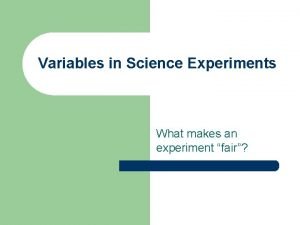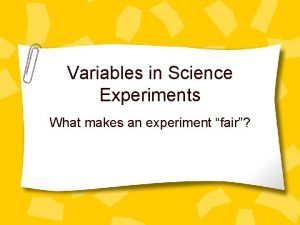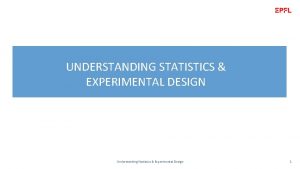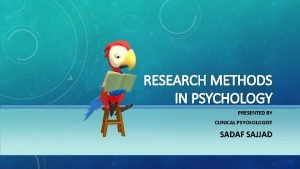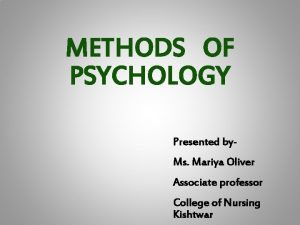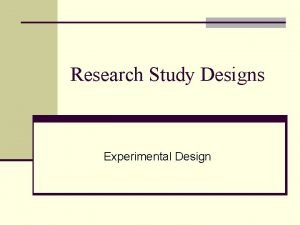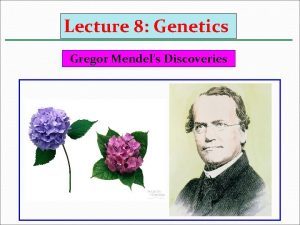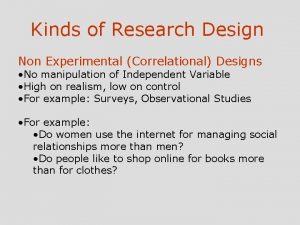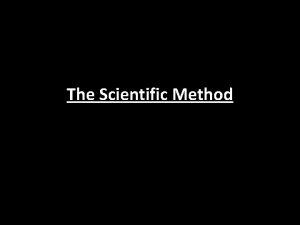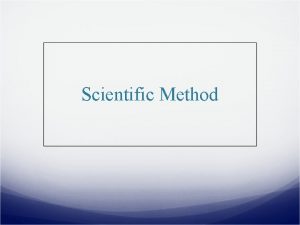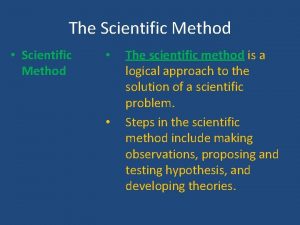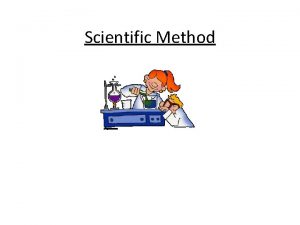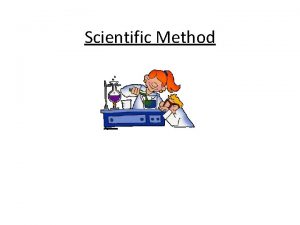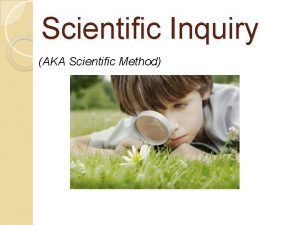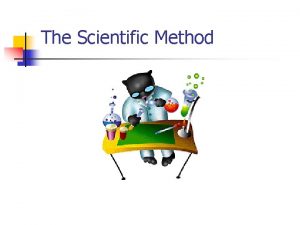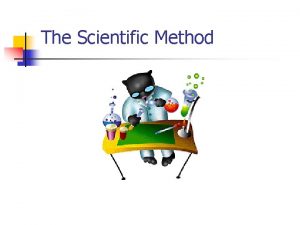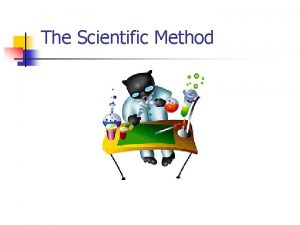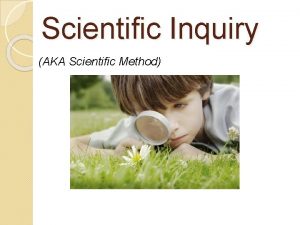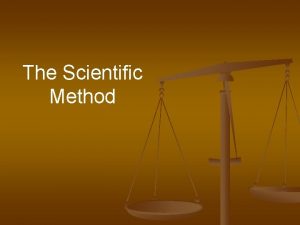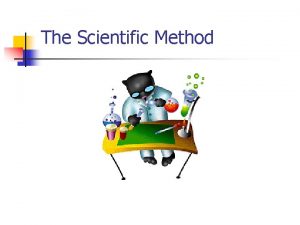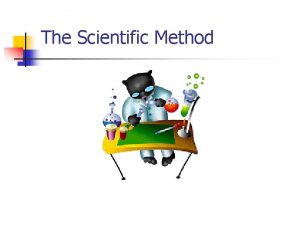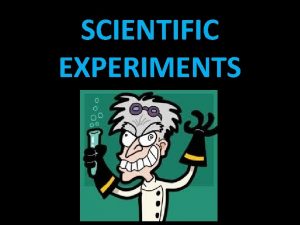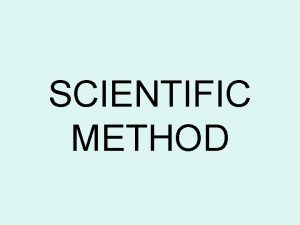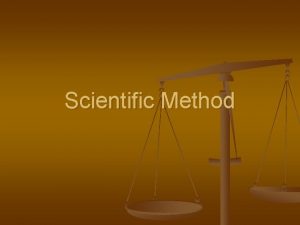The Scientific Method and Experimental Design The Scientific






























- Slides: 30

The Scientific Method and Experimental Design

The Scientific Method (OH TAC for everyday living) Hypothesize Observe Test and Analyze Conclude

The Scientific Method (OH TAC for everyday living) Hypothesize Observe Test and Analyze Conclude Observe! “Discovery consists of seeing what everyone else has seen and thinking what no one else has thought. ” Albert Szent-Gyorgyi as displayed on the wall at the MBL

The Scientific Method (OH TAC for everyday living) Hypothesize An Hypothesis is… • a possible explanation Observe • a question Test and Analyze Conclude • a guess

The Scientific Method (OH TAC for everyday living) Hypothesize Observe Test and Analyze Test • by further observation Conclude • by experimentation with • control setup • experimental setup • with only one variable!

The Scientific Method (OH TAC for everyday living) Analyze Hypothesize • Observe Test • organize data into patterns • tables • graphs • diagrams • drawings and photos • discuss sources of error Conclude and Analyze record data carefully • sketches, notes, numbers

The Scientific Method (OH TAC for everyday living) Conclude Hypothesize Observe • does the data support your guess (hypothesis)? • why or why not? Test and Analyze Conclude • what can you conclude?

The Scientific Method Again and Again Hypothesize Observe Conclude Test and Analyze Ob se rv e po th es iz Te an d al y ze st e and Analyze Hypoth Hy esize lu de Ob ser ve e Observ Test and e Analyz Hy po the siz e de Co nc Conclude Test Conclude and An Observe Hypothesize Conclu Tes t and An aly ze Con clu de

Dogs and Diarrhea Scientific Method 1. Observe 2. Hypothesize 3. Test 4. Analyze 5. Conclude

Scientific Method Practice • Does listening to ______’s music help improve test scores in biology class? • What info would you gather and how? • What is your hypothesis? • How would you perform the experiment? – What are the Control and Experimental Groups? • What data would you collect? • How would you make a conclusion?

Laboratory Report Format 1. Name and lab partner name(s)

Laboratory Report Format 2. Date of the Experiment

Laboratory Report Format 3. Lab Report Title • Captures Key Idea behind Experiment, or • Reason for Experiment, or • Conclusion Reached from Results

Laboratory Report Format 4. Hypothesis • a possible explanation • a question • a guess

Laboratory Report Format 5. Procedure a step-by-step description of how you did the experiment

Laboratory Report Format 6. Sketch of Setup a drawing (or drawings) showing the setup of your experiment

Laboratory Report Format 7. Results • restate the experiment in one sentence • • • present data in organized manner discuss data as it relates to hypothesis suggest possible sources of error explain how they may affect data summarize data

Laboratory Report Format 8. Conclusion • How did your results support or refute the hypothesis? • What follow on experiments might be done and why.

Why make notes and drawings? They are your personal record and a way to share your ideas and observations will others.

Famous Visual Journalists Graphische Sammlung Albertina, Vienna The Great Piece of Turf, 1503 Albrecht Dürer (German, 1471— 1528) Watercolor and gouache on paper; 16 1/8 x 12 5/8 in. (41 x 32 cm) Image courtesy of the Albertina, Wien

Famous Visual Journalists Studies for the Libyan Sibyl (recto); Studies for the Libyan Sibyl and a small Sketch for a Seated Figure (verso), 1508 -12 Made by Michelangelo Buonarroti (Italian, Caprese, 1475 - 1564, Rome) Italian Purchase, Joseph Pulitzer Bequest, 1924 (24. 197. 2)

Famous Visual Journalists MISSOURI HISTORICAL SOCIETY/GRANGER COLLECTION SAGE GROUSE A drawing of a sage grouse from the winter of 1805 -1806 with comments by Lewis.

Famous Visual Journalists Artist Unknown, "Horse with Arrows, " 17, 000 B. C. , prehistoric cave painting

The Beet Lab • Groups – Control Group? – Experimental Group? • Data – What to measure? – Qualitative and/or quantitative? • Variables – Controlled Variables – Independent Variables – Dependent Variables

Experimental Design • It’s all about 3 Variables – Independent Variables – Dependent Variables – Controlled Variables

The 3 Variables Controlled Variables factors that you make sure don’t change Dependent Variable One item or factor you measure Independent Variable One item or factor you change and observe it’s effect

Groups and Repetitions • Groups – – Control Group • Doesn’t receive treatment • No change in independent variable • “Baseline measure” to compare against – Experimental Group • receives the treatment • Independent variable • Number of Repetitions – how many times?

Two Types of Data Qualitative Data Observations that don’t contain numbers Quantitative Data Observations that can be measured using numbers

ED Practice Example A: Your thinking - The further you sit from Dr G, the less chance you will get caught using your phone. Hypothesis: If_____________, then___________. Independent Variable: Dependent Variable: Control Group: Experimental Group: Data Type: Qualitative : Quantitative What would the graph of the data look like?

ED Practice Example B: Boys raise their hand more in class than girls. Hypothesis: If_____________, then___________. Independent Variable: Dependent Variable: Control Group: Experimental Group: Data Type: Qualitative : Quantitative What would the graph of the data look like?
 Experimental vs non experimental
Experimental vs non experimental Experimental vs non experimental
Experimental vs non experimental Experimental vs non experimental
Experimental vs non experimental Disadvantages of experimental research
Disadvantages of experimental research Experimental vs non experimental
Experimental vs non experimental Scientific inquiry vs scientific method
Scientific inquiry vs scientific method What is the independent variable in science
What is the independent variable in science Experimental design independent and dependent variables
Experimental design independent and dependent variables Understanding statistics and experimental design
Understanding statistics and experimental design Ethical issues of experimental research
Ethical issues of experimental research Experimental design questions and answers
Experimental design questions and answers Experimental design and graphical analysis of data
Experimental design and graphical analysis of data Scientific method vs engineering design process
Scientific method vs engineering design process Scientific method vs engineering design process
Scientific method vs engineering design process Correlational research psychology
Correlational research psychology Experimental method of psychology
Experimental method of psychology Characteristics of experimental research design
Characteristics of experimental research design Quasi experimental design example
Quasi experimental design example N-of-1 study example
N-of-1 study example Non experimental research topics
Non experimental research topics Non experimental design
Non experimental design Characteristics of experimental research design
Characteristics of experimental research design Key principles of experimental design
Key principles of experimental design Are freckles recessive
Are freckles recessive Mendel's experimental design
Mendel's experimental design Mendel's experimental design
Mendel's experimental design Experimental research design
Experimental research design In watermelons bitter fruit (b) is dominant
In watermelons bitter fruit (b) is dominant Quasi experimental design notation
Quasi experimental design notation Randomized block design
Randomized block design Anova excel
Anova excel






